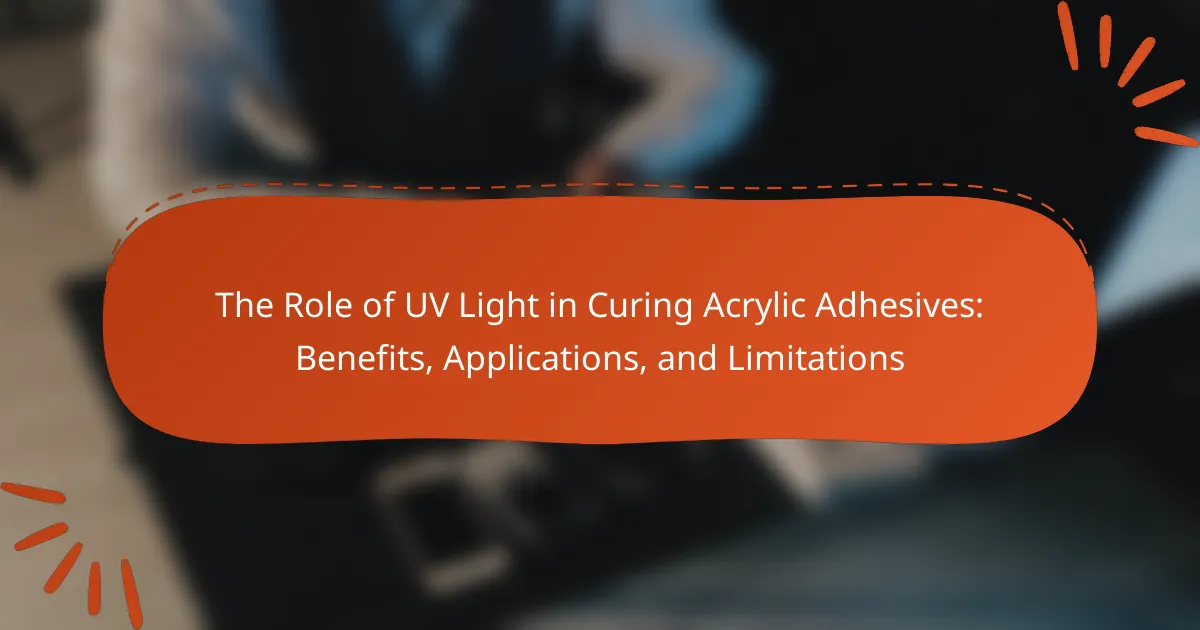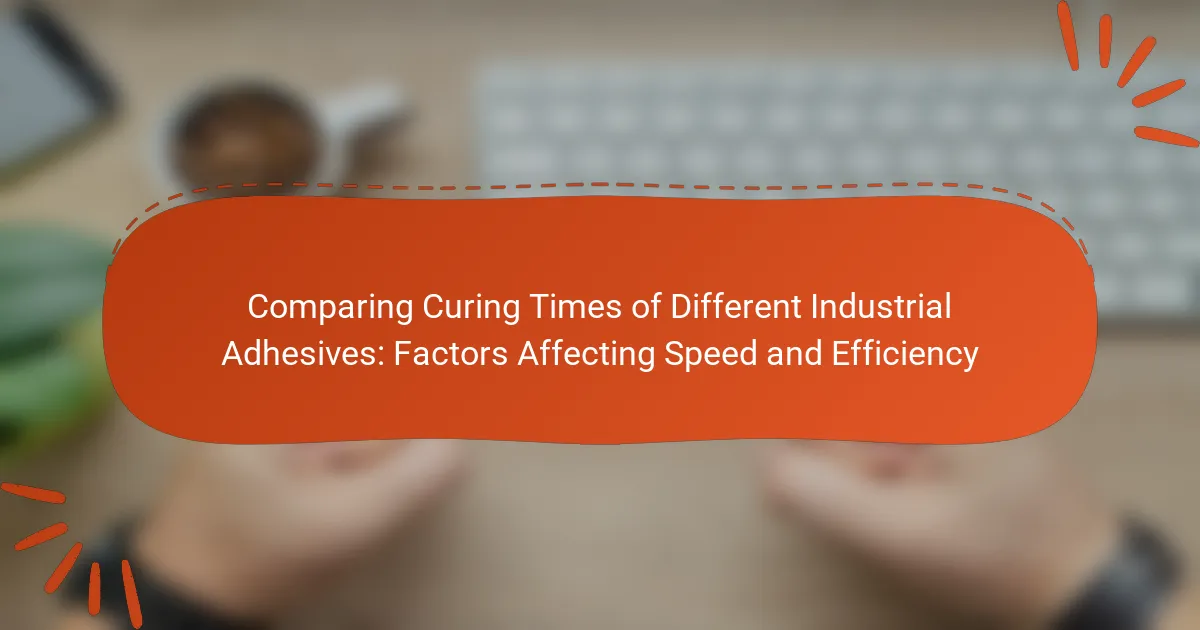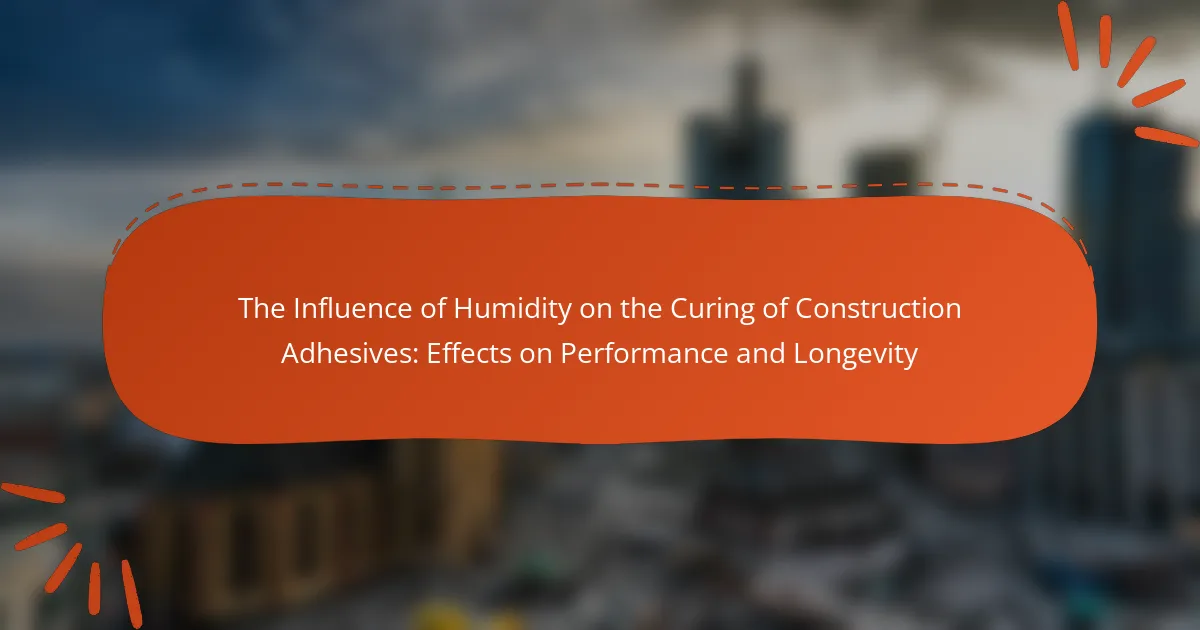UV light plays a crucial role in the curing process of acrylic adhesives by activating a photoinitiator that generates free radicals, leading to rapid polymerization. This technology significantly enhances production efficiency across various industries, including automotive assembly, electronics, medical device manufacturing, packaging, and woodworking. UV-cured acrylic adhesives are known for their durability and resistance to environmental factors, making them increasingly popular. The future of UV light curing technology is promising, with advancements in UV LED technology, a growing demand for faster curing processes, and favorable environmental regulations driving its adoption. Projections indicate substantial market growth for UV curing applications in acrylic adhesives by 2027.
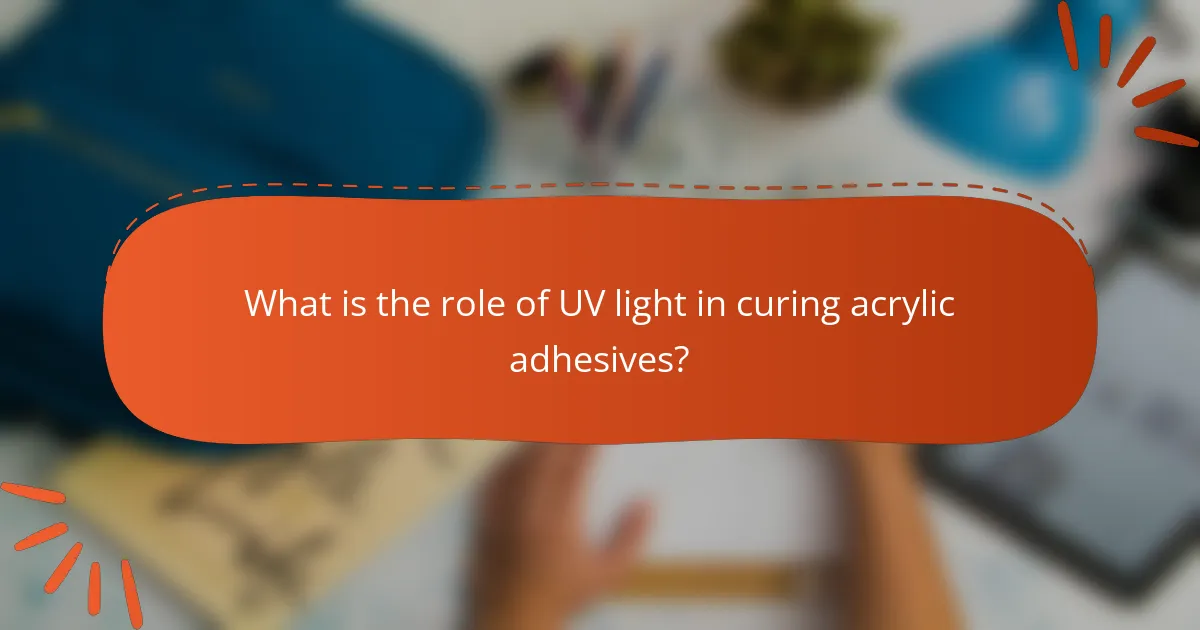
What is the role of UV light in curing acrylic adhesives?
UV light initiates the curing process of acrylic adhesives by triggering a photoinitiator. This photoinitiator generates free radicals when exposed to UV radiation. These free radicals then react with the acrylic monomers, leading to polymerization. As a result, the adhesive transitions from a liquid to a solid state. This curing process typically occurs within seconds to minutes, depending on the intensity of the UV light. The use of UV light enables faster production times and improved efficiency in adhesive applications. Additionally, UV-cured acrylic adhesives exhibit enhanced durability and resistance to environmental factors.
How does UV light initiate the curing process of acrylic adhesives?
UV light initiates the curing process of acrylic adhesives through a photopolymerization reaction. When exposed to UV light, photoinitiators in the adhesive absorb energy and generate free radicals. These free radicals then react with the acrylic monomers, initiating a chain reaction. This chain reaction leads to the formation of a cross-linked polymer network. The result is a solid, durable bond. Studies have shown that UV curing can achieve full cure in seconds to minutes, enhancing efficiency. This rapid curing process is beneficial in various applications, including automotive and electronics.
What are the chemical reactions involved in UV curing?
UV curing involves photopolymerization reactions. In this process, UV light initiates the curing of acrylic adhesives. The primary chemical reaction is the conversion of liquid monomers into solid polymers. This occurs through the formation of free radicals when photoinitiators absorb UV light. These free radicals then react with monomers, leading to chain reactions. The result is a cross-linked polymer network, which provides strength and durability. The process is rapid and can occur in seconds. This efficiency is one reason UV curing is widely used in various applications.
How does UV light intensity affect the curing process?
UV light intensity directly influences the curing process of acrylic adhesives. Higher UV light intensity accelerates the polymerization reaction. This results in faster curing times and improved adhesion properties. Conversely, lower UV intensity can lead to incomplete curing. Inadequate curing may compromise the adhesive’s strength and durability. Research indicates that optimal UV intensity ranges between 200 to 400 mW/cm² for effective curing. Variations outside this range can negatively impact the final properties of the adhesive. Thus, controlling UV light intensity is crucial for achieving desired performance in acrylic adhesive applications.
What are the benefits of using UV light for curing acrylic adhesives?
Using UV light for curing acrylic adhesives offers several benefits. It allows for rapid curing, often within seconds, enhancing production efficiency. UV light also enables precise control over the curing process. This results in reduced waste and improved adhesion quality. Additionally, UV-cured adhesives exhibit strong bond strength and durability. They are resistant to moisture and chemicals, making them suitable for various applications. The use of UV light minimizes the need for solvents, promoting a safer working environment. Overall, these advantages contribute to more efficient manufacturing processes and superior product performance.
How does UV curing improve adhesive performance?
UV curing enhances adhesive performance by rapidly polymerizing the adhesive, resulting in stronger bonds. This process occurs when UV light initiates a photochemical reaction, leading to cross-linking of adhesive molecules. The rapid curing reduces the time required to achieve full bond strength. Additionally, UV curing minimizes the risk of contamination during the curing process. As a result, adhesives cured with UV light often exhibit improved durability and resistance to environmental factors. Studies show that UV-cured adhesives can achieve up to 50% higher tensile strength compared to traditional curing methods. This makes UV curing a preferred choice in industries requiring high-performance bonding solutions.
What are the environmental advantages of UV curing over traditional methods?
UV curing offers several environmental advantages over traditional curing methods. It emits lower volatile organic compounds (VOCs), reducing air pollution. Traditional methods often release harmful solvents, contributing to smog and health issues. UV curing also requires less energy, as it cures instantly upon exposure to UV light. This efficiency leads to lower greenhouse gas emissions. Additionally, UV curing extends the lifespan of materials, reducing waste. Studies show that UV-cured products often have superior durability compared to those cured with heat or chemicals. This durability minimizes the need for replacements, further benefiting the environment.
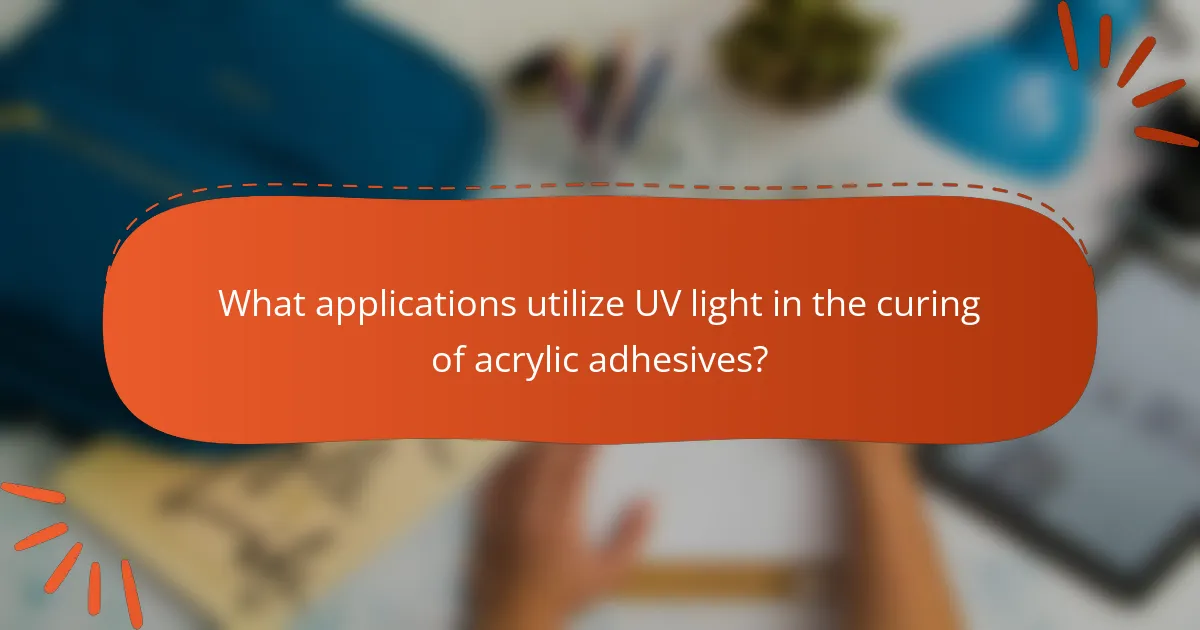
What applications utilize UV light in the curing of acrylic adhesives?
UV light is utilized in various applications for curing acrylic adhesives. Common applications include automotive assembly, where quick bonding is essential. It is also used in electronics for securing components and in medical device manufacturing for sterilization and bonding. Packaging industries employ UV curing for labels and seals. Additionally, woodworking uses UV light to bond laminates and finishes. The speed of curing enhances production efficiency across these sectors.
In which industries is UV curing of acrylic adhesives commonly used?
UV curing of acrylic adhesives is commonly used in the automotive, electronics, medical, and packaging industries. In the automotive sector, these adhesives bond components and are used in assembly processes. The electronics industry utilizes UV curing for circuit board assembly and component bonding. In medical applications, acrylic adhesives are used for device assembly and securing medical instruments. The packaging industry employs these adhesives for labeling and sealing products. Each of these industries benefits from the fast curing times and strong bond strengths provided by UV curing technology.
What specific products benefit from UV-cured acrylic adhesives?
UV-cured acrylic adhesives benefit various products, including optical devices, automotive components, and electronic assemblies. These adhesives provide strong bonds for glass and plastic substrates. They are used in the manufacturing of displays and lenses. Additionally, UV-cured acrylic adhesives are effective in bonding materials in the automotive industry. They enhance the durability of automotive lights and trims. In electronics, they secure components on circuit boards. Their fast curing time improves production efficiency. Overall, UV-cured acrylic adhesives are essential in industries requiring reliable adhesion and quick processing.
How is UV curing applied in manufacturing processes?
UV curing is applied in manufacturing processes by using ultraviolet light to initiate polymerization. This technique is commonly used for curing coatings, inks, and adhesives. In the process, a UV light source emits specific wavelengths that activate photoinitiators in the material. These photoinitiators generate free radicals, which then trigger the curing reaction. The result is a rapid solidification of the material, creating a durable finish. Industries such as printing, automotive, and electronics frequently utilize UV curing for its efficiency. According to a study by the American Coatings Association, UV curing can reduce drying times by up to 80%. This technology enhances production speed and improves product quality.
What are the limitations of using UV light for curing acrylic adhesives?
The limitations of using UV light for curing acrylic adhesives include incomplete curing in shadowed areas. UV light does not penetrate opaque materials effectively. This can lead to weak bonds in hidden joints. Additionally, the effectiveness of UV curing is dependent on the intensity of the light source. Insufficient intensity can result in longer curing times or incomplete polymerization. UV light also requires careful handling to avoid skin and eye damage. Finally, some acrylic adhesives may yellow over time when exposed to UV radiation. These factors limit the application of UV curing in certain environments and materials.
What factors can affect the efficiency of UV curing?
The efficiency of UV curing is affected by several factors. These include the intensity of the UV light, which influences the curing speed. The wavelength of the UV light is also crucial, as different materials require specific wavelengths for optimal curing. The distance between the UV source and the material affects exposure time. Additionally, the type of photoinitiator used can impact the curing process. The thickness of the adhesive layer plays a role, as thicker layers may require longer curing times. Environmental factors, such as temperature and humidity, can also influence efficiency. Finally, the presence of any contaminants on the surface can hinder proper curing.
What are the potential health and safety concerns associated with UV light usage?
Potential health and safety concerns associated with UV light usage include skin damage, eye injury, and the risk of burns. Prolonged exposure to UV light can lead to skin cancer due to DNA damage in skin cells. The World Health Organization states that UV radiation is a known carcinogen. Eye exposure can cause photokeratitis, which is akin to sunburn of the cornea. This condition can result in temporary vision loss. Additionally, UV light can cause burns on unprotected skin. Proper protective equipment, such as goggles and sunscreen, is essential to mitigate these risks.
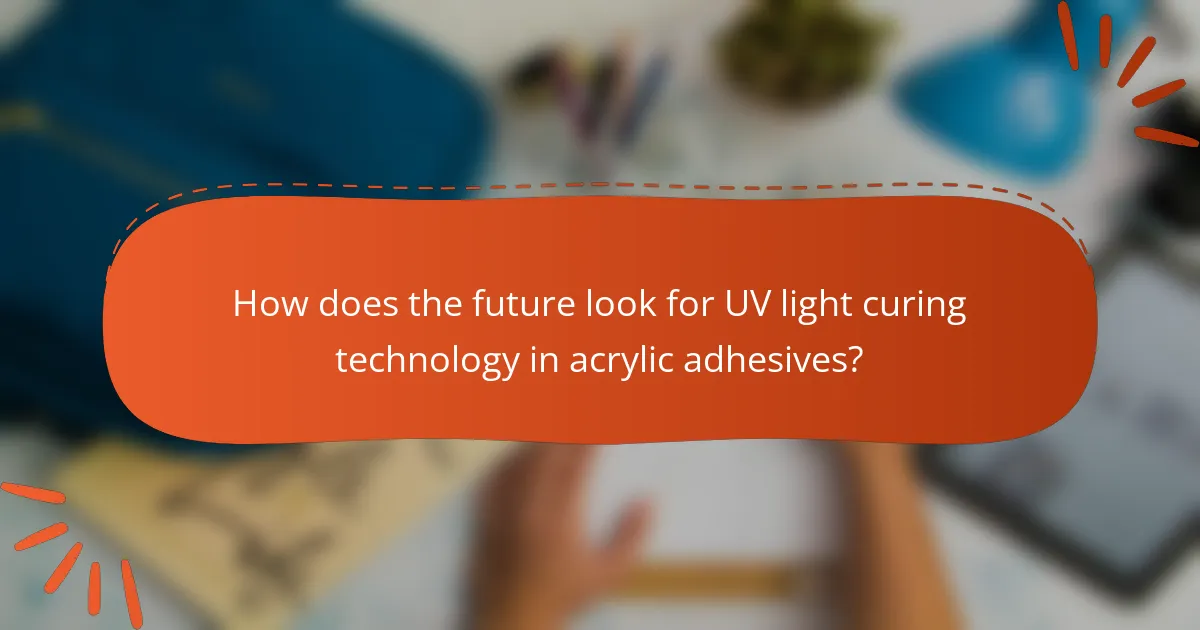
How does the future look for UV light curing technology in acrylic adhesives?
The future of UV light curing technology in acrylic adhesives looks promising. Advancements in UV LED technology enhance efficiency and reduce energy consumption. Increased demand for faster curing processes drives innovation in formulations. Environmental regulations favor UV curing due to reduced volatile organic compounds. The automotive and construction industries are adopting UV-cured adhesives for their reliability. Continuous research is improving adhesion properties and versatility of applications. Market growth projections indicate a significant rise in UV curing adoption by 2027. These factors collectively indicate a robust future for UV light curing technology in acrylic adhesives.
What advancements are being made in UV curing technology?
Recent advancements in UV curing technology include the development of high-intensity LED UV lamps. These lamps offer faster curing times and reduced energy consumption. Additionally, new formulations of UV-curable materials have improved adhesion and flexibility. Enhanced monitoring systems for curing processes ensure optimal performance and quality control. Research has focused on expanding the range of substrates compatible with UV curing. Innovations in photoinitiators have led to lower odor and improved safety profiles. Furthermore, advancements in automation are streamlining the UV curing process in industrial applications. These developments collectively enhance the efficiency and effectiveness of UV curing technology.
How might new technologies improve the curing process?
New technologies can enhance the curing process by increasing efficiency and precision. Advanced UV light sources can provide consistent energy output. This consistency leads to uniform curing across surfaces. Improved sensors can monitor the curing process in real-time. These sensors can adjust UV exposure based on material response. Automation technologies can streamline the application of adhesives. This reduces human error and increases throughput. Research indicates that optimized curing times can improve adhesive strength. Studies show that precise control of UV light enhances bond integrity.
What best practices should be followed when using UV light to cure acrylic adhesives?
Use UV light at the appropriate wavelength for curing acrylic adhesives, typically around 320-400 nm. Ensure that the adhesive is evenly applied to maximize exposure to UV light. Maintain a consistent distance between the UV light source and the adhesive surface for uniform curing. Monitor the curing time, as overexposure can lead to degradation of the adhesive properties. Employ protective eyewear to safeguard against UV exposure. Ensure adequate ventilation in the workspace to avoid inhaling fumes from the curing process. Test the cured adhesive for strength and adhesion to confirm optimal curing. Follow manufacturer guidelines for specific products, as formulations may vary.
What tips can enhance the effectiveness of UV curing in practical applications?
To enhance the effectiveness of UV curing in practical applications, ensure optimal UV light intensity and wavelength. The intensity should match the adhesive’s requirements for proper curing. Use UV lamps designed for specific applications to maximize energy output. Maintain a consistent distance between the light source and the surface being cured. This distance affects the amount of UV light reaching the adhesive. Additionally, ensure the surface is clean and free from contaminants to promote adhesion. Consider using reflectors to direct more UV light onto the adhesive. Monitor the curing time based on the adhesive’s specifications for best results. Lastly, evaluate the environment for factors like temperature and humidity, as they can impact curing efficiency.
The primary entity of this article is UV light and its role in curing acrylic adhesives. The article provides an in-depth analysis of how UV light initiates the curing process through photoinitiators, resulting in rapid polymerization and solidification of adhesives. Key benefits of UV curing include improved production efficiency, enhanced bond strength, and environmental advantages over traditional methods. It also addresses various applications across industries such as automotive, electronics, and medical, while discussing limitations and best practices for effective UV curing. Additionally, advancements in UV curing technology and future prospects are explored, highlighting its growing significance in manufacturing processes.
